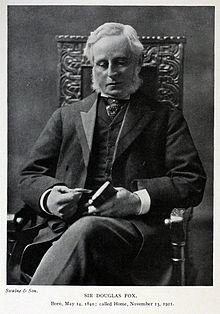Charles Douglas Fox
| Douglas Fox | |
|---|---|
 |
|
| Born |
14 May 1840 Smethwick, Staffordshire |
| Died | 13 November 1921 (aged 81) |
| Engineering career | |
| Discipline | Civil |
| Institutions | Institution of Civil Engineers (president) |
Sir (Charles) Douglas Fox (14 May 1840 – 13 November 1921) was an English civil engineer.
Douglas was born in Smethwick, Staffordshire, the oldest son of Sir Charles Fox and had two brothers and a sister. Sir Charles was a civil engineer and had designed, amongst other things, The Crystal Palace in Hyde Park. Douglas was educated at Cholmondeley School, also known as Highgate School, from 1851 to 1854 and King's College School from 1854 to 1855. He studied at King's College London from 1855 to 1857 and was to have studied further at Trinity College, Cambridge but the financial collapse of his father's contracting company in 1857 ended his education. Douglas was instead articled to his father who had set up an engineering consultancy, Sir Charles Fox and Sons.
Douglas was a member of the Church of England and was active in the Church Mission Society as well as being the author of several academic papers.
He married Mary Wright in 1863 with whom he had one son and four daughters.
In 1863 Douglas was made a partner and by 1865 the firm was involved in major projects in Britain, the USA, Canada, southern Africa, India, Australia, and South America. From 1863 to 1866 Douglas and his father worked on the design of the railway viaducts and bridges at Battersea which would separate the lines coming from Waterloo from those from Victoria. This process also included the widening of Grosvenor Bridge from two to seven tracks.
Douglas served as an officer in the Volunteer Force London Rifle Volunteer Brigade and was commissioned as an Ensign in that unit on 17 June 1861. He received promotion to Lieutenant in that unit, since renamed the London Rifle Volunteer Corps, on 18 November 1863. During this period Douglas held several patents including one for "improvements in machinery for nicking and dressing the heads of screw-blanks" which was approved on 28 April 1868, one for "improvements in the manufacture of method of repairing railway rails and other iron in a permanent way and in the machinery to be employed therein" on 30 July 1868 and one for "improvements in screw cutting and threading machines and in the construction of screw nails and spikes" on 30 April 1866. The latter two patents expired after a seven-year period for non-payment of stamp duty required for a patent extension. Douglas was also a member of the Institution of Civil Engineers by 1873.
...
Wikipedia
